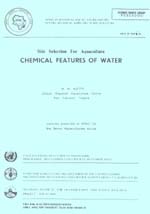
CHEMICAL FEATURES OF WATER
| Working Paper | ARAC/87/WP/12(9) |
 |
Site Selection For Aquaculture CHEMICAL FEATURES OF WATER |
M.N. KUTTY
African Regional Aquaculture Centre
Port Harcourt, Nigeria
Lectures presented at ARAC for the Senior Aquaculturists course
AFRICAN REGIONAL AQUACULTURE CENTRE, PORT HARCOURT, NIGERIA
CENTRE REGIONAL AFRICAIN D'AQUACULTURE, PORT HARCOURT, NIGERIA
UNITED NATIONS DEVELOPMENT PROGRAMME
FOOD AND AGRICULTURE ORGANIZATION OF THE UNITED NATIONS
NIGERIAN INSTITUTE FOR OCEANOGRAPHY AND MARINE RESEARCH
PROJECT RAF/82/009
MARCH, 1987
Hyperlinks to non-FAO Internet sites do not imply any official endorsement of or responsibility for the opinions, ideas, data or products presented at these locations, or guarantee the validity of the information provided. The sole purpose of links to non-FAO sites is to indicate further information available on related topics.
This electronic document has been scanned using optical character recognition (OCR) software. FAO declines all responsibility for any discrepancies that may exist between the present document and its original printed version.
2. CHEMICAL COMPOSITION OF WATER
4.1. Factors Involved in Reduction of D.O.
4.3. Dissolved Oxygen in Relation to Temperature and Salinity
4.4. Oxygen Levels in Natural Waters
4.5. Oxygen Regime in Fish Ponds
4.6. Control of Oxygen in ponds
4.7. Oxygen relations of Fishes
4.8. Oxygen Requirements of Brackishwater Shrimps
5. CARBON DIOXIDE, PH, ALKALINITY AND HARDNESS
7.2. pH Requirement of Brackishwater Shrimps
7.3. pH Photosynthesis in Fish Ponds
11.1. Hydrogen sulfide and shrimps